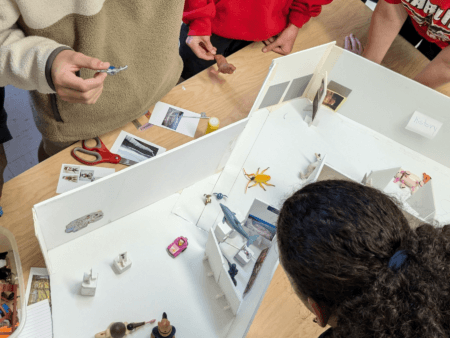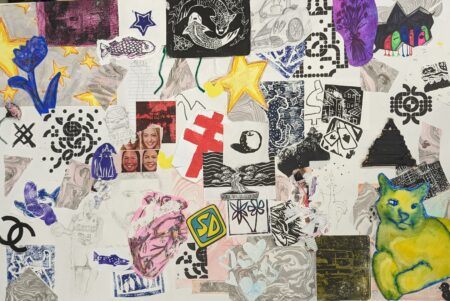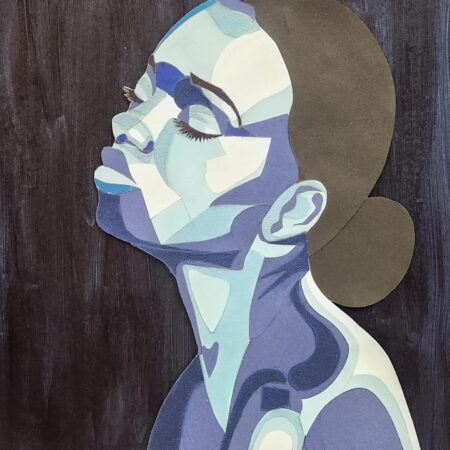Teaching with Contemporary Art
Encouraging Media Exploration & Meaning Through Contemporary Art
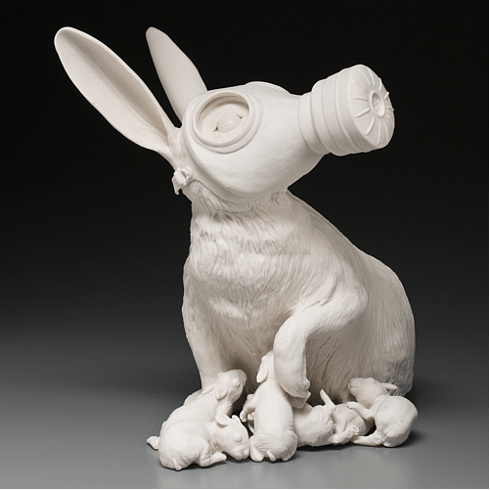
IMAGE: Kate MacDowell, First and Last Breath, 2010.
In viewing MacDowell’s (2010) First and Last Breath, what do you see? Do you see a soft, fluffy animal, represented in hard, fixed porcelain? Do you focus on the gas mask? Do you wonder how a rabbit managed to obtain and secure a gas mask to its head?
Contemporary art often meets us in a place of obscurity and causes us to question familiar objects, unusually presented. In a middle school art class, we explored the juxtaposition of MacDowell’s rabbits and a gas mask by collaborating on two lists. Students were first asked what concepts come to mind when thinking of only bunnies; then, they were asked what they associate with only gas masks. After compiling the two independent lists, students noticed opposites such as “natural” versus “man-made,” and similarities such as “protection.” They made connections between the rabbit protecting her bunnies and the gas mask protecting her; that the natural environment is utilizing a man-made object of protection against a threat that man created; and that these cute, non-threatening, prey animals with little defensive strategies are impacted by human action and must go to extremes to adapt and protect themselves in the world we created. Pictured is a whiteboard list of the words students collectively brainstormed when we focused on each juxtaposed object independently.
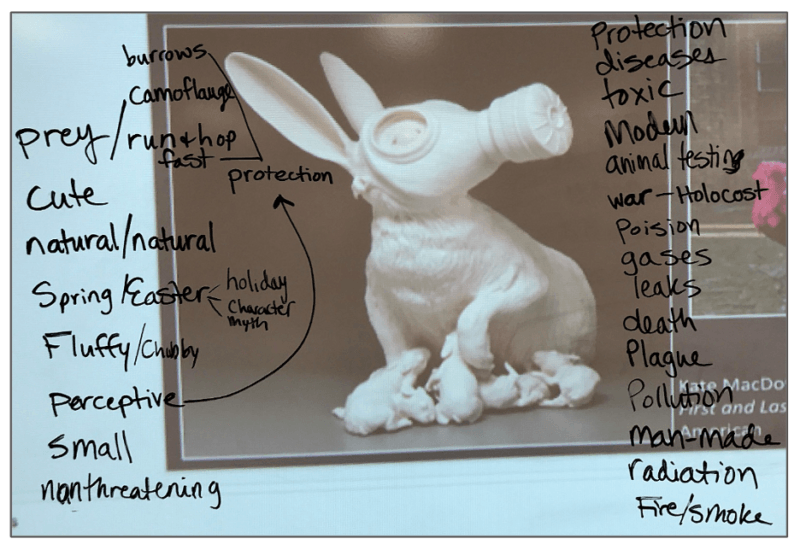
IMAGE: Photo courtesy of Jennifer Bockerman.
While this depiction of a rabbit in a gas mask matches a North American or European representation, the animal appears in many cultures — for example, the rabbit in the Chinese Zodiac, or a lucky rabbit’s foot. In this class, students pushed the association of the rabbit with the Easter holiday into characters and myths. When we allow students to drive explorations, they will bring more to the conversation from their various lived experiences than we, as an individual teacher, could ever present!
Contemporary art provides a rich platform for deep inquiry. MacDowell’s First and Last Breath (2010) is one piece included in a curated list of contemporary artworks I use to engage students in “close looking,” or deeper observation, communication, generative thinking, analysis, and meaning making. The concepts that often come up in contemporary art manage to both echo and outlast their immediate historical context, and call us as viewers to question whose story and voice is presented and by whom; the life and meaning an object holds; how materials can be used, and how the location within the space affects the artwork’s meaning. Curations of artworks invite us to connect the dots and set the stage for themes to emerge. In addition to MacDowell’s First and Last Breath (2010), this curated list included Nick Cave’s Rescue Series (2013), Nicholas Galanin’s The American Dream is Alive and Well (2012), Daniel Lind-Ramos’ Vencedor: 1797 (2018-19), Brian Jungen’s Prototype for New Understanding #8 (1999), and Jeffrey Gibson’s Like a Hammer (2011-19). Additionally, students discussed the artworks’ topics, materials, and perceived meaning as a scaffolded method for creating their own work.
To prepare the class before viewing this curated list of artworks, students were shown more examples of juxtapositions in advertisements and art. Reflecting on the Creative Conceptual Thinking Strategy of juxtaposition (Julia Marshall), students reflected on their new understanding of how pairing two different objects can create new meaning. Students then practiced with a timed challenge to combine two unrelated objects or opposites using magazines to collage a quick juxtaposition piece, which they then shared and discussed. This was a fast exercise, as students caught on quickly, often surprising me with aspects of the objects and combinations I wouldn’t have conceived. Juxtaposition became just one new tool for students to practice making meaning and communicative art.

Top Row IMAGES: Nick Cave, Rescue Series, 2013. Nicholas Galanin, The American Dream is Alive and Well, 2012. Daniel Lind-Ramos, Vencedor: 1797 (Victorius: 1797), 2018-2019.
Bottom Row IMAGES: Brian Jungen, Prototype for New Understanding #8, 1999. Jeffrey Gibson, Like a Hammer (Installation view), 2011-2019. Kate MacDowell, First and Last Breath, 2010.
The other contemporary artworks were more complex, so we first had to identify what we were seeing. Harvard Project Zero’s See, Think, Wonder exercise was helpful because we often want to jump to what we think, but See, Think, Wonder slows students down to first observe, noticing what is physically present. It is so interesting where students will direct these conversations. I simply provide questions and prompts, and the students bring their own histories to the artworks! For example, after identifying the discarded kitsch objects that Nick Cave collected and repurposed in his Rescue Series, I might ask, Which objects seem to hold value and why? The discussion then might lead to why the artist chose to juxtapose seemingly valuable objects with discarded objects. I may ask, How does the idea of being ‘rescued’ relate to the repurposed objects and to the dog? Do you think the artist positioned the dog as surrounded, covered, hidden, protected, enveloped… and what might that intention in positioning mean?
As we explored the other artworks from the curation, students began seeing patterns as certain concepts emerged for multiple pieces: protection, rescue, fight, flight, conquer, control, power, identity, cover… When students considered the materials, they examined what meaning the objects contributed: discarded, found, handmade, mass produced, wealth, power, class, identity, symbol… They noticed artwork from different disciplines: science, ethnography, politics, history, pop culture, climate… And so on.
These aspects of contemporary art opened up art making from traditional media, displayed in traditional ways, created by the traditional canon of white European males to something more broadly relatable, relevant, and accessible. Any interest could be pursued, explored, and communicated through art! Any material could be used to experiment and further meaning! Artwork was no longer limited to a realistic painting or drawing hanging within the walls of a museum, yet the skill of a material remained present. Contemporary art opened up a call to possibilities!
Inspired by a new agency to interact with various materials, two grade 8 students, Claire & Mila, began combining their similar interests and ideas about fashion and the environment. They were excited to move beyond traditional art materials and began media tests. Experimenting with canvas, pulled tissue paper dye, laser print transfers, transparency sheets, sewing, material patterns, adhesives, permanent marker, China marker, charcoal, and oil pastels, the students Claire & Mila created layers of material and meaning. Their visual commentary explored fast fashion’s impact as an industry on the environment.

IMAGES: Photos courtesy of Jennifer Bockerman.
Grade 6 student, Piper, decided to look through the collection of found materials in the art room. She saw old shoes and decided to bring her own used pair to class. Piper was thinking about the form and function of shoes and how we often sacrifice comfort for style. She was looking for something beautiful to combine with something uncomfortable or painful. She found some peacock feathers and spiky seed pods. Piper used the colors found in the peacock feathers to mix paint for the altered shoe. She used the positioning of the shoes and the footprints to signal an altered gait in step. Her mixed media artwork is titled Pretty Ugly.
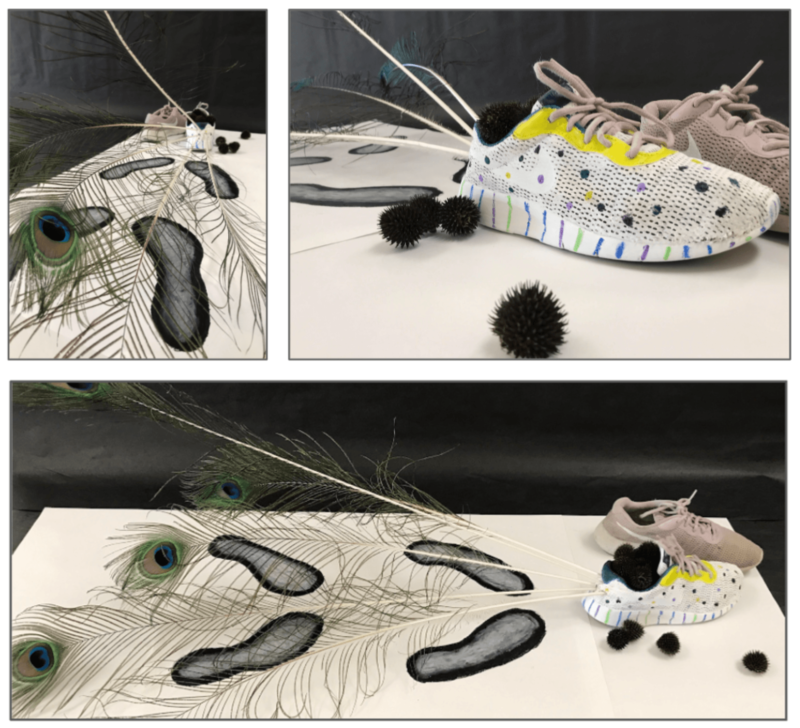
IMAGES: Photos courtesy of Jennifer Bockerman.
Grade 8 student, Andre, was also interested in shoes. Andre brought his interest and passion for collecting and following Nike shoes to the art room. He thought about comparing Nike sales and the economy. He considered designing his own custom Nike design—prototyping a new functional feature. He thought about Nikes as a status symbol and what that meant, in particular for middle school students. Eventually Andre decided to investigate material waste and options for upcycling Nikes—generating an alternative to continued mass production. We put out a call for donated Nikes and checked local thrift shops. Using an exacto-knife to deconstruct the shoes, Andre then used paint, glue, faux leather, faux fur, and fake dollar bills, along with repurposed foam, real leather, and shoe laces to reconstruct upcycled Nikes. For his last pair, Andre designed the Nike price tags to comment on the price comparison between the same shoe with one nonfunctional customization—the dollar bills. His attention to detail and skills with the materials grew as his edits became barely detectable throughout his sustained inquiry.

IMAGES: Photos courtesy of Jennifer Bockerman.
Contemporary artists bring unconventional materials and objects steeped in context, history, and personal meaning to their work. They represent identities, experiences, and perspectives from around the globe, just like the current classroom environments. Expression through these forms of artwork do not necessarily require a technical skill set, a mastery of language, or a confidence to speak in front of others — all of which are still being nurtured, and can be cultivated through the practice itself. Students learn to communicate through visual arts directly. Experiencing contemporary art helps us to become more aware, acknowledge new ideas, consider different perspectives, and think about the multimodal ways in which we might communicate our own ideas, interests, or discoveries with an amplified voice.

